Sea Pines Resort, Hilton Head, SC
United States of America
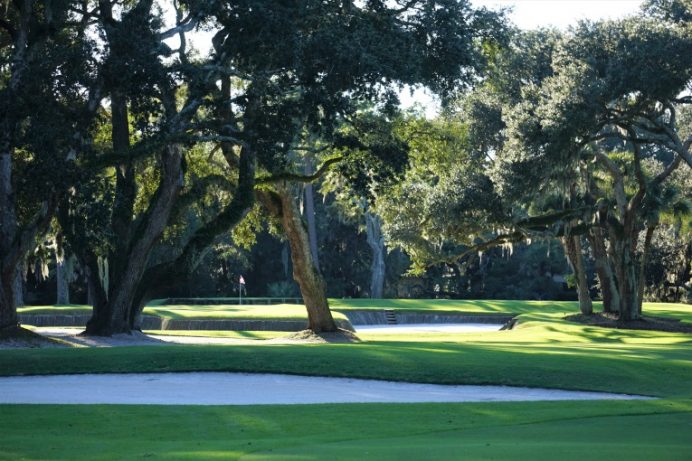
Its Lowcountry vibe and low profile features have ensured that Harbour Town’s allure remains as strong today as in 1969 when Arnold Palmer won the inaugural PGA Tour event played here.
The story of Harbour Town can’t be told enough as there are so many important takeaways. There is the vision of Charles Fraser and how he believed golf and homes could coexist and the manner in which he went about doing so. There is the collaboration between Jack Nicklaus and Pete Dye that both changed the trajectory of modern architecture while inspiring a host of future would-be architects. Their architecture embodied what later became known as minimalism (i.e. moving dirt only where needed to create good golf). There is the reintroduction of variety in regards to hazards – their shapes, sizes and where they fall within the holes. Additionally, possessing greens nearly half the size of other greens built in that era, Harbour Town became a game changer with its emphasis on each and every green site posing interesting and diverse questions. Indeed, the author contends that Harbour Town and Sand Hills are the two defining events in golf course architecture in North America since World War II. That thesis is explored throughout this profile.
The story starts with visionary Charles Fraser. At the mere age of 26, he formed the Sea Island Company for the express purpose of building low density housing on the southern end of Hilton Head Island. Given its beaches and unspoiled charms derived from live oaks and scented pines, he was convinced that people would like both to vacation and retire to this idyllic island. At that time in the mid-1950s, a scant 500 people lived on Hilton Head but Fraser readily saw its immense appeal. He started selling lots in 1956 and by the mid-1960s with things going well, he approached the PGA about hosting an event on Hilton Head. With that commitment secured, he then approached the game’s hottest star Jack Nicklaus to build what he hoped would be a world-class course. Nicklaus was intrigued but also at the height of his considerable playing powers. His schedule was full so he brought in his fellow Buckeye and friend Pete Dye to drive the course’s construction. Nicklaus did so in part because Dye had recently used him in the creation of The Golf Club outside of Columbus, Ohio where Nicklaus hit a number of shots as holes unfolded there. Fraser remarked ‘I have never heard of this fellow Dye.’ Nicklaus responded, ‘Don’t worry, you will. Trust me.’
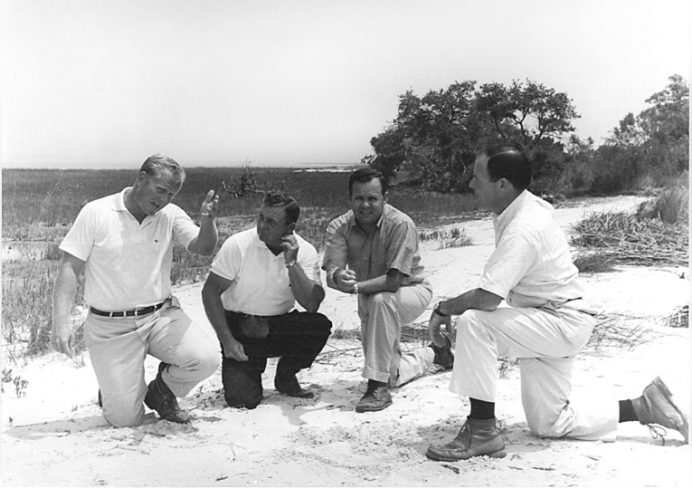
Nicklaus, Donald O’Quinn, Charles Fraser and Pete Dye at Harbour Town, pre-construction. (Courtesy of the Nicklaus Archives)
Fraser’s Sea Pines Company controlled the southern 8,000 acres of the 25,000 acres that make up Hilton Head. Dye got to work late in 1967 and Nicklaus made a whopping 23 visits throughout the project. The build was relatively quick, taking just fourteen months. The course hosted its PGA event on schedule in November, 1969. Drexel Heritage Furniture was the sponsor and if a player made a hole-in-one on seventeen, he received a suite of furniture. Certainly different times!
What the professionals encountered was unlike anything they had played. Instead of large rolling greens bunkered left and right and a course in the 7,000 yard range, they played a 6,655 yarder with oddly configured greens that fell between 3,500 to 4,100 yard square feet. The greens didn’t possess severe breaks nor was their challenge predicated upon speed. The longest par three measured under 190 yards and two of the three par fives were reachable in two. Five par fours measured under 400 yards. The high to low point of the property was six feet so topography was hardly the underpinning of the test either. There was no real reason to believe that something extraordinary would emerge. Yet it did. How?!
Clearly, the interaction between Nicklaus and Dye proved invaluable throughout the construction but something occurred four years prior that was also crucial: Pete Dye went to Scotland in hopes of qualifying for the 1963 British Amateur Championship at St. Andrews. This was the first time that either he or his wife Alice had been. As he writes in Bury Me in a Pot Bunker, ‘Thirsty for new concepts, Alice and I studied and photographed as we played and began a library of ideas and concepts for future course designs.’ All told they visited thirty courses but he makes note that ‘five of them presented spectacular images that would substantially influence the design of every single golf course we would build in the future.’ Those were Turnberry, Prestwick, Carnoustie, Royal Dornoch and The Old Course at St. Andrews.
In regards to Prestwick, he makes several revealing statements in Bury Me in a Pot Bunker. Naturally, he was struck by the use of sleepers or railroad ties, noting, ‘ I was fascinated by their ability to add a striking, demanding dimension to the course by not only providing a means to control erosion but also presenting the golfer with a highly visible obstacle.’ He sums up Prestwick thusly: ‘ Prestwick is a delightful test that features its famous railroad ties, pot bunkers, multicolored heather, seaside bent grass, cavernous bunkers, blind holes, narrow sloping fairways, and the menacing Pow Burn ( a winding weaving creek). Adding to the challenge is a prevailing wind that one day may be a zephyr and the next a tempest. Despite its difficulty, Prestwick plays to just 6,544 yards, and I was amazed that this short course could present such a formidable challenge.’
What else did he encounter there? Tees suppressed to the ground, bunkers of varied shapes and sizes, central hazards, greens of all shapes and sizes, and putting surfaces that slope away from the player. What does Harbour Town feature? Tees suppressed to the ground, bunkers of varied shapes and sizes, central hazards, greens of all shapes and sizes, and putting surfaces that slope away from the player. By Dye’s own admission, such similarities aren’t a coincidence and the Dyes’ Scotland 1963 adventure clearly marks another example whereby Americans traveled to Scotland and were later able to translate what they saw there on this side of the pond.
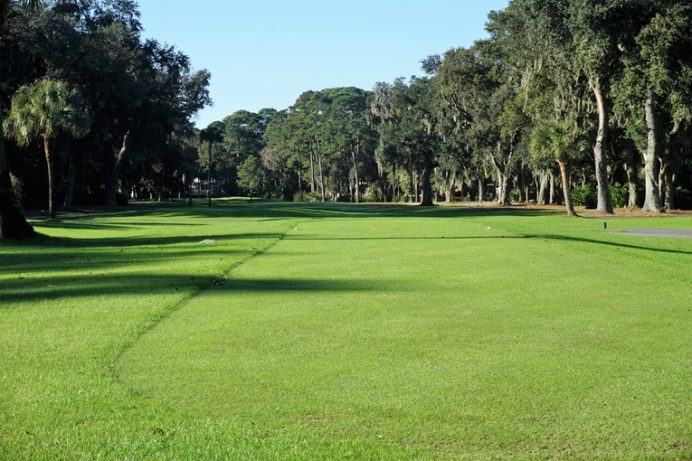
Features from Prestwick found at Harbour Town: uncomplicated tees at grade like here at the 3rd …
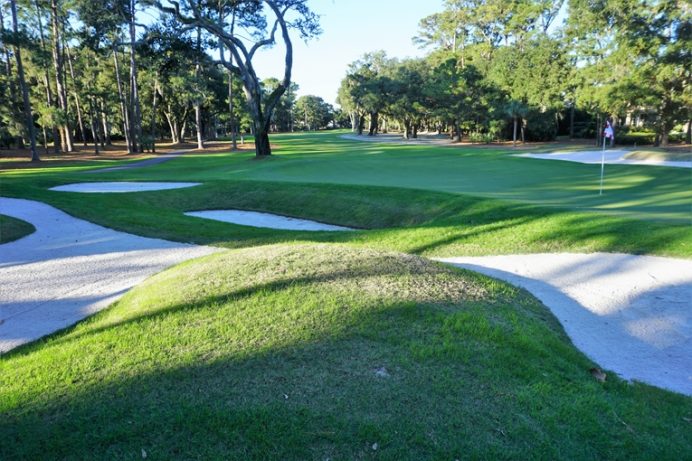
… bunkers of varied shapes (and elevations!) like these four at 11 …
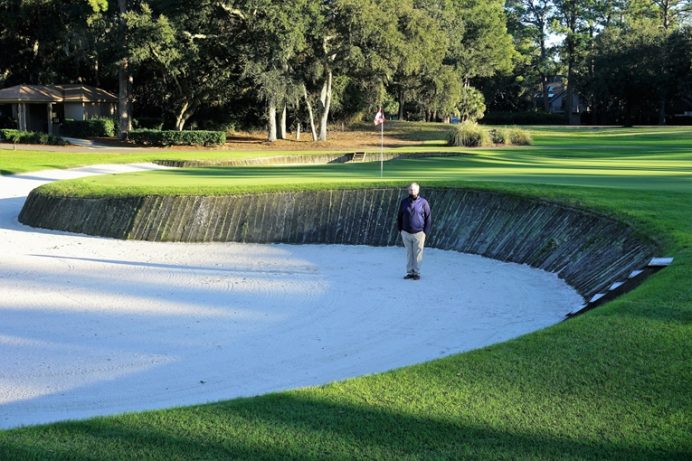
… and sizes like this one at 13 with its railroad ties.

Additionally, there are greens of all shapes (photo courtesy of PJ Koenig Golf Photography) …

… and sizes like the XXXX square foot one at 12 (photo courtesy of Sky Realty).
Plenty of architects have pushed the design envelope, sometimes to great original effect and other times not, such as when they introduce waterfalls or other man-made contrivances that go against the simple but profound pleasure of hitting your ball, finding it and hitting it again. Dye and Nicklaus did things differently at Harbour Town but the features that they introduced were steeped in history. Below is the Alps bunker at Prestwick, one of several bunkers to feature railroad ties for the past 150+ years. Suffice to say, Prestwick has stood the test of time – and history is now proving that Harbour Town has too. The joke early on was that Dye had built a course that could burn down but such jokes likely lacked an appreciation of the game’s root.
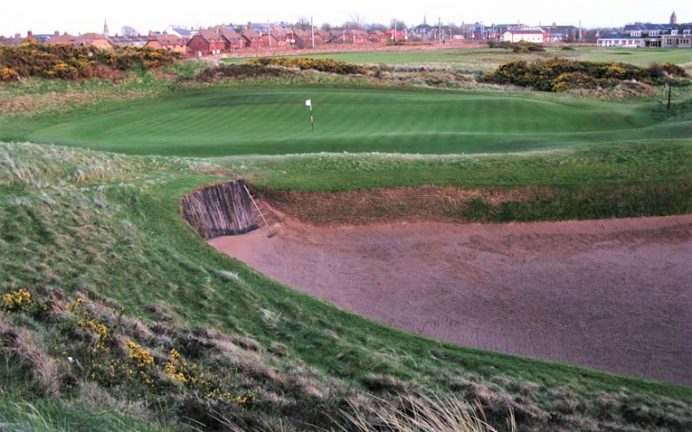
The greater the variety of hazards, the greater the course.
Seventy-five plus yard long bunkers had not really debuted in America in the 1960s. Take a look at a really fine architect like Dick Wilson and his masterpiece at Pine Tree in Florida. Similarly flat to Harbour Town and opened in 1961, Pine Tree received immediate accolades, in part because of its sandscape and Wilson’s proliferation of bunkers. The wayward golfer may conclude that bunkers are everywhere but the largest one is 55 yards in length. Yes, scores of others enjoy spacious footprints but nothing like the range of bunkers at Harbour Town. Ignoring the sandscapes and referring only to bunkers at Harbour Town, some of the most noteworthy ones include the 95 yard long one at seven, the 110 yard long one at eight, the U shaped 45 yard wide greenside one at thirteen, the 135 yard waste bunker at sixteen, and the 105 yard long one at seventeen. Dye’s inspiration? Where else but his trip to Scotland where he encountered oddly shaped hazards like the 75 yard long but narrow Cardinal bunker at Prestwick’s third hole. Indeed, David Fleming, Head Golf Professional at Prestwick, played golf with Perry Dye at Prestwick a few years ago. Over lunch, Pete’s son spoke freely of his Dad’s love for Prestwick and how much it influenced his designs.

The 75 yard Cardinal bunker at Prestwick, complete with – you guessed it – railroad ties.
As for the build itself, Dye kept things simple, displaying his Indiana roots and midwestern sensibilities. If he needed dirt to create an appealing green complex, it invariably came from nearby. Cary Corbitt, long time Vice President of Sports & Operations at Sea Pines, spent scores of hours with Dye going around Harbour Town. He notes that Dye always spoke of ‘building down to go up.’ Examples abound. For instance, straightaway at the first, Dye scalloped out a section of fairway several feet down so that he could then build the first green complex a few feet higher from its surrounds. Most famously, at the fortress-like thirteenth green, Dye went down to create the bunker and used that material to build up the green complex. Essentially by flipping the soil, the depth to the famed thirteenth fronting bunker is twice that of what he moved. All commonsense stuff that helps explain why the course lays so peacefully upon the land to this day. What it doesn’t explain is why architects in the 1980 and 90s went haywire doing wall-to-wall shaping when the ideal had been presented at Harbour Town in 1969! But that’s another story.
Many neat ideas were unveiled at Harbour Town in a manner consistent with their surrounds. Though they provided an initial jolt, time has shown they weren’t gimmicky. And with Nicklaus hitting shot after shot, the shot values that emerged from the collaboration between Nicklaus and Dye were top drawer. And ultimately, that is what lures both the professionals and resort guests back year after year. The golf is of such a high quality and so many singular holes exist that can only be played here. Fraser got what he wanted: a world-class course as defined by an unrelenting series of unique, arresting holes. However, all the great design work could have been for naught if the perimeter of the holes wasn’t protected. After all, Fraser’s vision was that people would head to Hilton Head to bond with nature and if the overall sense was that you were playing between rows of homes, that connection would be lost.
Thankfully, Fraser immediately set a high standard for the size and color of homes that would border the course. Nothing above two stories and no paint color that would call attention to any man-made edifice. Such restrictions were critical to the enduring success of the course.

This photograph looking down the long 15th fairway shows that Fraser’s restrictions for building were not only well conceived but have been carefully and steadfastly enforced for five decades.
Indeed, when discussing Harbour Town, the word ‘ambience’ invariably comes up. Listen to Canadian architect Jeff Mingay and the reverence he shows for the design: ‘For me, the Lowcountry and its ambience have a lot to do with my love for Harbor Town. The neat thing is that the course fits that setting so well … which is probably why I’m accepting of big mossy oaks factoring into the challenge to the degree that they do. The architecture is perfect for that site. We’d label it ‘restrained’ these days and the shaping doesn’t try to overcome what is mostly flat ground. Yet, at the same time, Harbor Town is one of the most creative courses ever conceived. Not only are the holes in each par category remarkably varied and memorable, no one had ever seen holes like 9, 13 and 16 before Harbor Town! It’s a wonderful example of how to do an interesting, distinctive course in seemingly restrained style.’
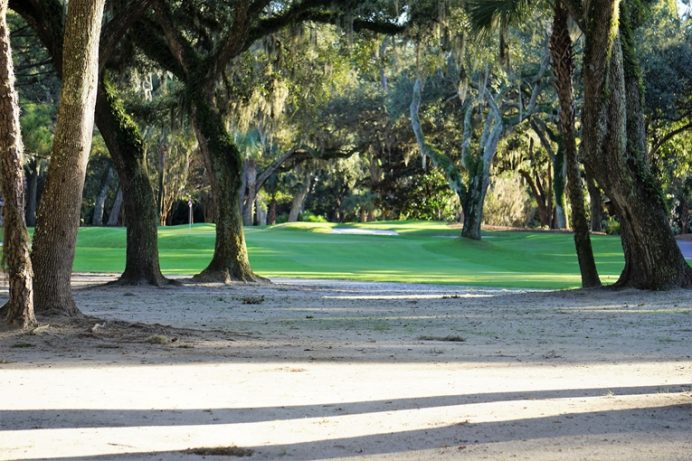
Life has a slower cadence in the Lowcountry, a fact that Harbour Town’s architecture readily embraces.
Before touring the holes below, the author shares this story from Brad Faxon. In 2008, we were at Eastward Ho! together for an event and the question was posed of him what were his favorite PGA Tour courses. He immediately mentioned Harbour Town stating words to the effect, ‘Too few courses we play ask the player to shape the ball. If we aren’t careful, courses will soon only reward the long hitter. Harbour Town is different. You have to play thoughtful, tactical golf and the occasional intrusion of trees into play reward the player who can move his ball either way while controlling its trajectory. We need more designs like Harbour Town.’ Well said and traditionalists fully appreciate/support such sentiments. Indeed, with the passage of time and what technology has done this century, the kind of golf that Harbour Town espouses – tactical, thoughtful, inventive – is again back in vogue. Yet, no architect readily builds a 6,600 yard course today with 3,800 square foot greens, eschewing that for courses bigger in scale that devour more land and take longer to play. After one round here, just like in 1969, the golfer leaves wondering, Why?
Holes to Note
First hole, 410/380 yards; The golfer’s acumen is tested right away, though what exactly the test is, is not immediately discernible! The flattish hole looks innocuous, what Donald Ross would describe as ‘a gentle handshake.’ Yet, more years than not, this hole finishes in the top half for difficulty in the RBC Heritage, averaging around par. Time has taught them that trying to muscle the hole is pointless. The salient points are this is an island fairway, the green is angled from front right to back left and (surprisingly) runs away from the player, and two pine trees alternate narrowing in from either side. The vast majority of professionals now hit a ~265 yard ball for position in the right center of the fairway. From that vantage point, the player hits down the spine of the angled green but needs to be mindful that the back half of the putting surface slopes away. Indeed, with fairway grass extending well beyond the back edge of the green, the prudent miss is often long. To the author, Harbour Town was one of the first modern designs that encouraged the use of a putter from off the green. Give Green Keeper Jonathan Wright (the course’s only Green Keeper this century) tons of credit for the tight playing surfaces found throughout the course.
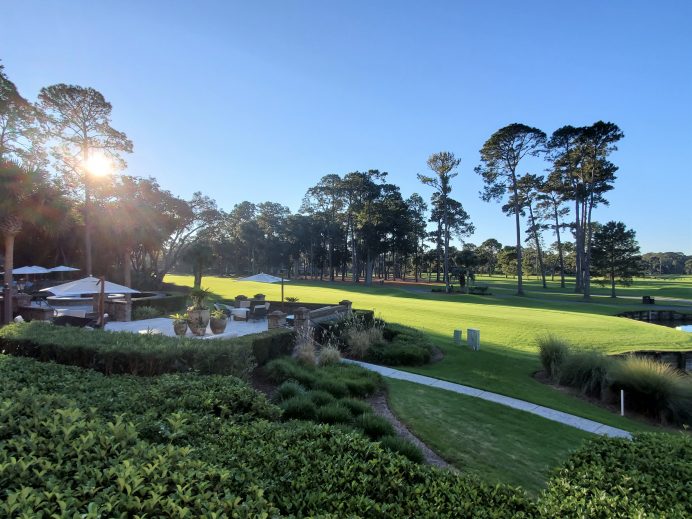
The enticing view from the Inn & Club at Harbour Town of the next door 1st tee on a clear, crisp December morning.
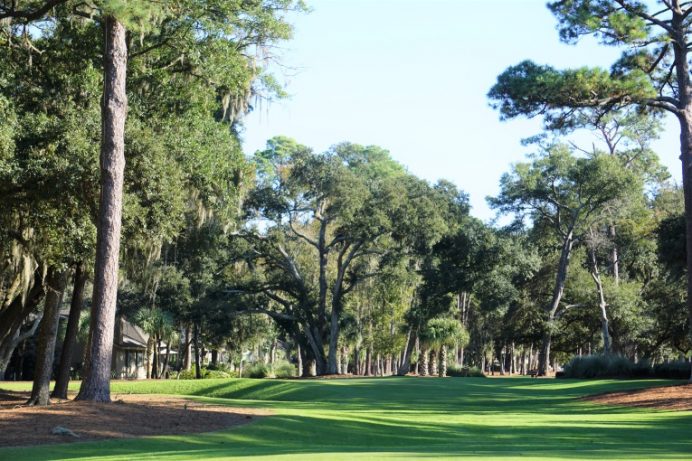
The pine tree on the left is 60 yards from the front of the green and the one on the right is 30 yards. Should the tee ball not be placed properly, either pine becomes problematic, likely requiring the player to demonstrate proficiency in shaping and controlling the flight of his approach shot.

For a flat course, Harbour Town possesses an uncommon amount of mystery. The first timer is confounded to discover that the slightly elevated 1st green runs away.
Third hole, 470/380 yards; Harbour Town has never been about length but rather variety. Still part of variety means asking players to hit a range of clubs into greens. In terms of length that has been added since 1969, the biggest single addition is found here at the third. Ninety yards (!) has been added but it was done so seamlessly as the new back tee for the Heritage is actually closer to the second green than the original tee. In fact, the second hole is a reachable par 5 and plays as the course’s easiest hole; the beastly third is a perfect compliment to that one and the professionals are content if they take 8 shots to cover the ~1,000 yards between the two. Subtlety still rules the day. The slight bend in the third fairway favors a draw with the player keen to avoid the 150 yard long sandscape right of the fairway. The rub is how the green is offset to the fairway with back right hole locations requiring an artful fade into the green. There are more overtly stiff challenges at Harbour Town where a double bogey or worse is possible but Shot Link confirms that a back right hole location guarantees that this sleeper gem will be one of the day’s three most difficult holes.
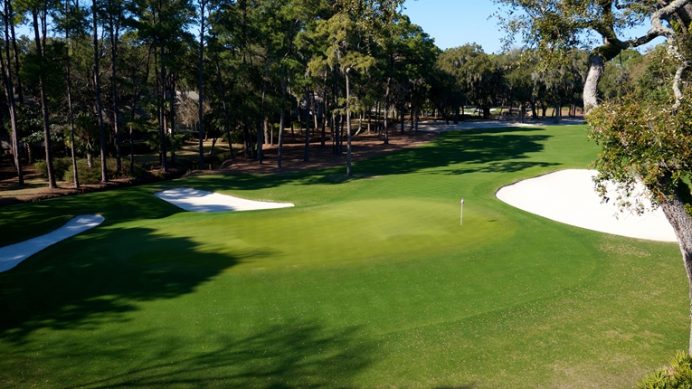
The angled 3rd green as seen from behind (photo courtesy of Sky Realty).
Fourth hole, 200/165 yards; The first of Harbour Town’s world-class holes, one can only imagine how jarring this hole was when first experienced in the late 1960s and 1970s. Courses like Doral featured water but it was invariably presented with rolled down grass banks feeding down into it. Here, railroad ties mark a stark, abrupt delineation between glory and failure. Dye went on to build many more such holes but this (and fourteen) was the first where railroad ties were used to ominous perfection at a resort course. The beauty of the hole is its flexibility. In 2015, when played from the back marker to the dreaded back left hole location, the hole was the day’s hardest. Yet, in round one, when the hole was set in the friendly back right (i.e. away from the water), it played as the second easiest hole. In recent years, the PGA Tour has had fun with the pairing of a shorter tee to a back left hole location, essentially wooing the player to be more aggressive than is prudent. Alice Dye’s guiding influence is seen here too with the forward tees right of the lagoon, taking the forced carry out of the equation.
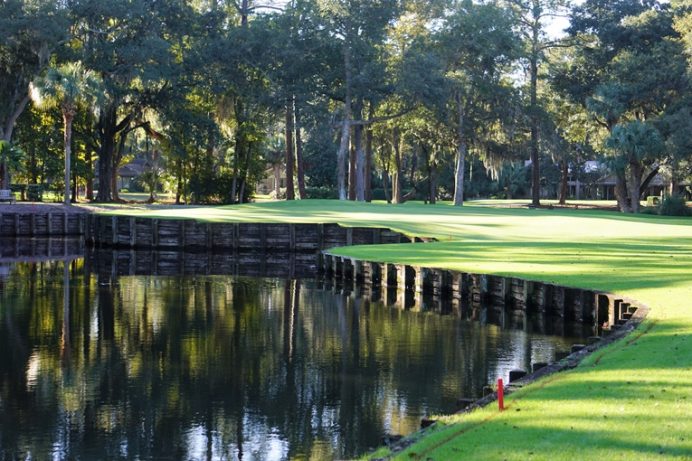
An early morning photograph of the 4th, before the flag was put in. Note how the one shotter simultaneously possesses an air of serenity as well as a steely edge.

As seen from behind, the lagoon also wraps around the green’s back left. The popular – and prudent – miss is front right.
Fifth hole, 550/495 yards; One of the reasons Harbour Town remains a pure delight to play is its give and take architecture. We saw it at the second and third and again here at four and five. Even if the golfer has had the misfortune to miss left at four, Dye immediately presents the opportunity to bolster the player’s spirts with this reachable par five. Not surprisingly, this modest length three-shotter features the most fairway bunkers off the tee of any hole with five. If those are avoided, the chance to reach the plateau green in two presents itself. A pond left (one of only two man-made ponds on the course) lends this slight dogleg left its teeth as does its elevated green. Not quite a plateau green, this green is nonetheless the most elevated of any on the course, being built up six feet from its surrounds. Indeed, it started life back and to the right some 40 yards but it was uncomfortably close to the out-of-bounds. In 1999, Dye moved it to its current location and gave it its elusive, hard to hit-and-hold qualities from ~220 yards. Still, at 550 yards, the fifth routinely plays the second easiest on the course, after hole two, for the professionals. The pressure is on: the veteran player knows he must have his scorecard in good order standing on the sixth tee because he is about to play seven par fours in the next eight holes that explore every facet of the game.
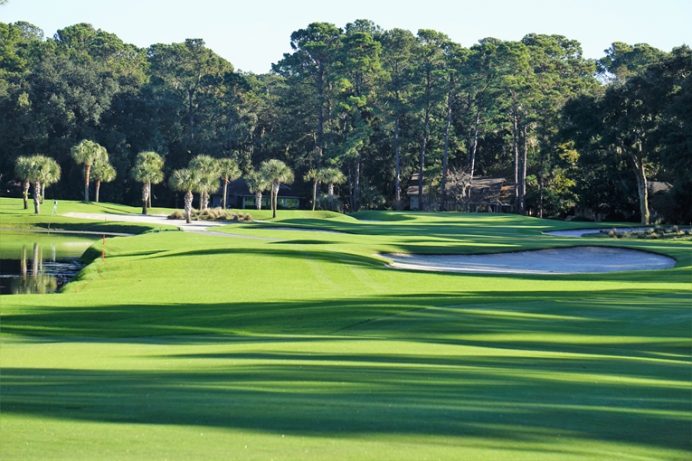
The pond left keeps the player honest, both off the tee and with his second shot.
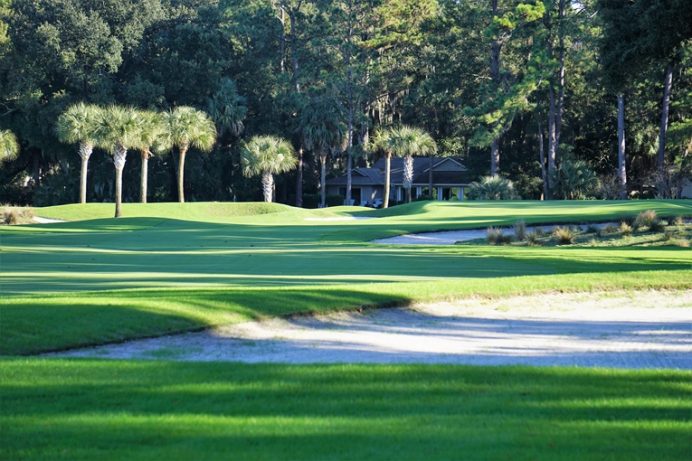
A well-played tee ball leaves this view from 220 yards of the elevated 5th green.
Sixth hole, 420/375 yards; Another of Dye’s takeaway from Scotland was how grasses were used for contrast. In the 1960s, new courses were monochromatically green across North America. Experimentation with grasses, colors and contrast had yet to get underway. Dye helped change that, first at Crooked Stick and then at The Golf Club. At Harbour Town, large clumps of pampas grasses were sporadically planted but it was Dye’s innovative use of large sandscapes that lend several holes the desired contrast and visual interest. Here, a large sandscape left and bunker right define the challenge off the tee on this slight dogleg right. Similar to the third, the green is cocked at an angle to the fairway and the long rectangular green is twice as deep as it is wide. This time, back left hole locations are the bête noire.
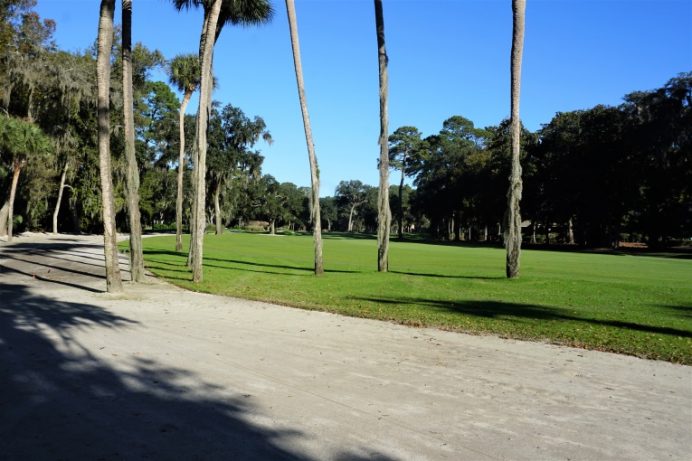
This 155 yard sand scape is found left of the fairway. Glued to the ground, Dye could have made it more flamboyant but that would have betrayed its Lowcountry setting. A lot of times in architecture, simplicity is best. Next time you play here, imagine the hole without it and you’ll gain a renewed appreciation of the benefit derived from the visual contrast of the off-white sand to the Celebration Bermuda fairways.
Seventh hole, 195/160 yards; Harbour Town measured under 6,700 yards when it opened and today the professionals tackle it around 7,100 yards, which helps keep its shot values in place. As we saw at the third, the good news is that the majority of the new back tees actually shorten the walk from the prior green. For instance, this hole has picked up 30 yards since inception by merely extending the tee back toward the sixth green. Indeed, the walking culture is stronger today at Harbour Town than it ever has been. Carry your bag, take a trolley or a caddie but for goodness sake, walk! Similar to Pinehurst No. 2, hilliness is absent, so there are no excuses. Audubon International stamps Harbour Town as a Certified Audubon Cooperative Sanctuary, and whether you pass egrets or alligators, take time to admire the environment. Here at this imaginative one shotter, three live oaks occupy the green complex that floats in a sea of sand. Other clubs might have cut down one or all of the trees but not here. Yes, prudent branch trimming will forever remain part of the equation but, as you see below, the character-laden trees add another playing dimension that is worth such efforts.
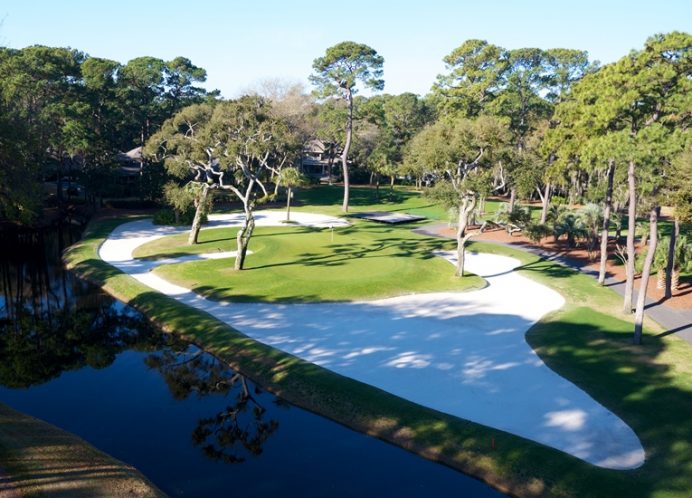
Turf exists back right of 7. Otherwise, Dye’s first island green would have come at at Harbour Town (photo courtesy of Sky Realty)!
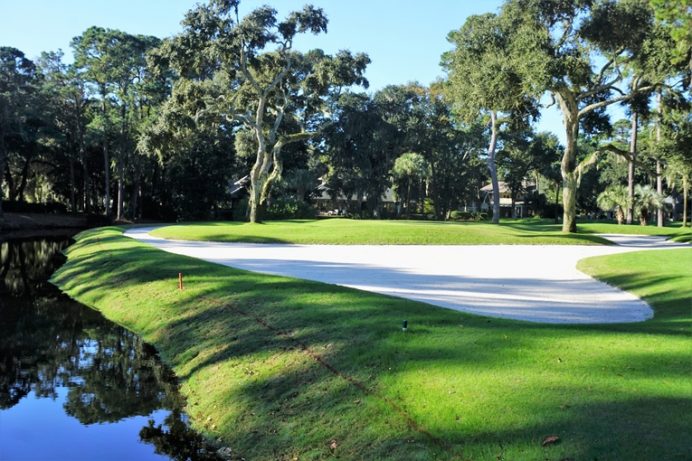
The 35 yard deep green sits within the confines of a bunker that stretches for 95 yards.
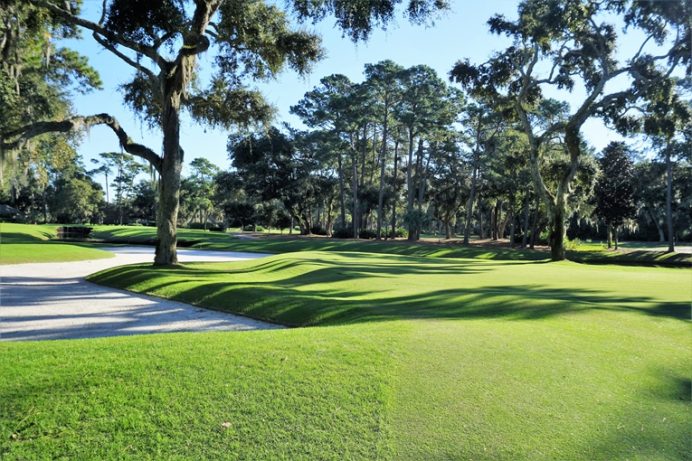
A pair of oaks stand sentinel and flummox even the professionals.
Eighth hole, 475/405 yards; When the Morrissetts first played the course in 1981, we did so having poured through its profile in the 1976 The World Atlas of Golf. We knew what to expect at holes like four, thirteen, seventeen and eighteen but the two holes that blew us away were the eighth and ninth. The eighth did so in its utter simplicity. A single strip bunker extended from behind the green out along a lagoon for 110 yards. The green sits innocently beside it and better yet, there is an ocean of grass to the right. Sure, the hole possesses length but none of the playing features scream at the player. That is, until you get to the top of your backswing for your approach. Only a numpty would pull one left into the lagoon. Missing in the strip bunker isn’t the worse fate but once a ball starts turning left, who knows if it will behave and find the sand and not the water? What really preys on the golfer’s mind is all the grass right and the apparent safety that it represents. Why not head that way and take away the prospect of a big number? The tension between the dire threat left and safe harbor right is delicious. The green is more than twice as long (30 yards) as it is wide (13 yards) and routinely ranks as the least hit green in regulation with only ~1/3 of the players doing so over four days at the RBC Heritage. Such a clever design, pity that there aren’t more graceful, similarly uncluttered holes like it world-wide.

As seen from behind, the 8th epitomizes great architecture in that the architect gives the player any number of ways to play the hole. The dullest form of architecture is when an architect dictates that only one type shot will suffice. Here, Dye doesn’t make you go for the green. In fact, he makes it abundantly clear that maybe you shouldn’t! The range in options both befuddle AND generate a strong desire for another round.
Ninth hole, 330/300 yards; Here is what this hole had going for it: Nothing. Not a single natural feature or lagoon or anything that would make it memorable. The playing corridor was flat, straight and short. If ever a hole was doomed to be a dud, this was it. Yet in a tour de force display of ingenuity, what emerged is one of the great short two shotters in world golf. A couple of pine trees narrow the approach angle but the kicker is the green complex. It is the exact opposite of the prior one. Instead of being a long rectangle, it is a wide but shallow ‘V’, with a fronting bunker augmented by three smaller, nastier ones in the inside of the V. The green is more than twice as wide (30 yards) as deep (13 yards on the inside of the V). The beauty of such a green complex is self-evident as it requires thought. If the hole location is left, the player drives right and vice versa. With today’s technology, professionals try and drive into the front bunker when the hole is set back. When it is in the narrow middle, they tend to lay-up to their favorite gap wedge distance. First timers might even have an advantage because they don’t suffer from scar tissue developed from past debacles! Old timers know to look at the flag from the nearby first hole and formulate a strategy before they arrive on the tee. Endlessly fascinating permutations of events unfold here. Dye and Nicklaus showed the world how to create something from nothing in 1969 and the tragedy to the author is that more architects never followed suit in some sort of (even loose) homage to this thoroughly original hole.
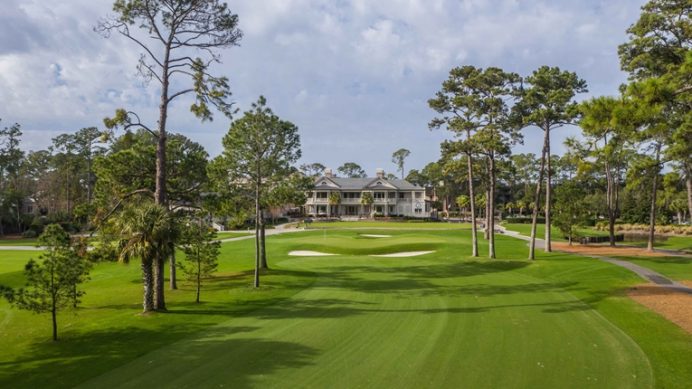
Well, this is different (photo courtesy of PJ Koenig Golf Photography)! The wide but shallow 9th green sits defiantly in front of the clubhouse.
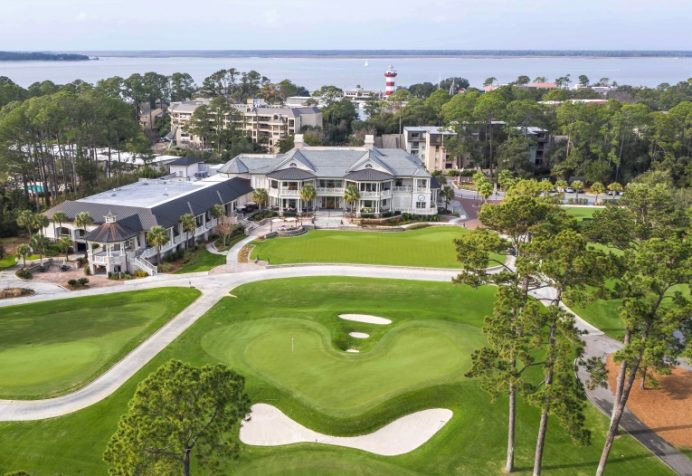
The day’s back left hole location in the aerial suggests playing right off the tee (photo courtesy of PJ Koenig Golf Photography).
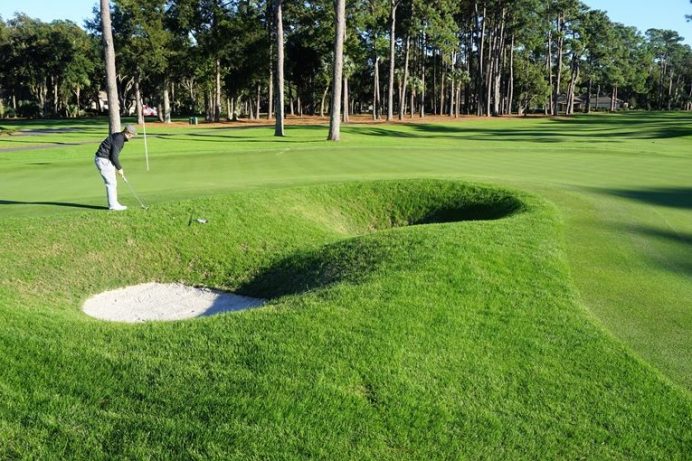
This ground level photograph from behind shows a front right hole location. The tactics off the tee are completely different to the two aerial photographs above.
Tenth hole, 450/400 yards; As the green pads themselves are low profile in nature, Dye didn’t need too much material and therefore, he only built two ponds, one on the front nine at the fifth and one on the back nine here. The judicious use of water is an underpinning to the design. Sometimes, it is in your face at the one shotters (e.g. the fourth and fourteenth), sometimes it is hidden from the tee (the fifth), sometimes it is used to threaten the second shot (e.g. the fifteenth) and several times a bunker acts as a buffer between the green and water (e.g. the seventh, eighth, seventeenth). Here, the pond is starkly in your face off the tee, something that has yet to occur in the round, making the tenth the course’s single nerviest drive, at least to the author. Two gorgeous live oaks pinch in the playing corridor 55 yards from the front of the green and are configured so that a drive right center is ideal. The green is quite deep at 40 yards but à la the eighth green, none too wide at 15 paces across. There are simply no ‘blah’ oval targets at Harbour Town; each one poses something of genuine interest.

There are 5 or 6 shots in the round that are imperative to get right, including the tee ball at 4, the approach to 9 and here, the tee ball at 10.
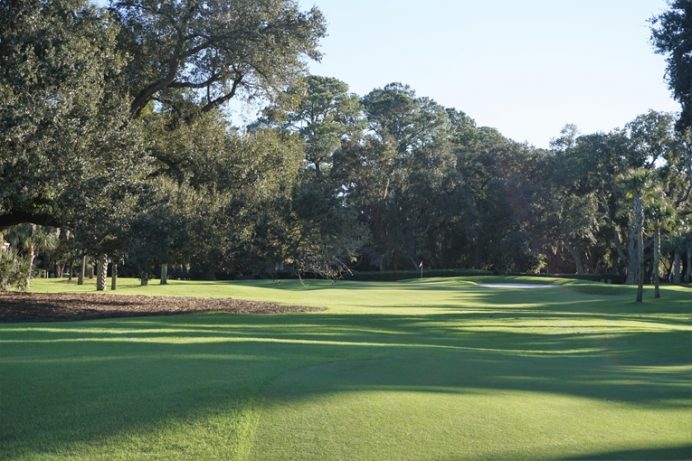
The architects intentionally did little to aid the golfer in gaining depth perception. Much like in Scotland, the element of feel is important at Harbour Town.

This view from behind shows the role that the oaks play on one’s approach.
Eleventh hole, 435/385 yards; Into the woods we go for three holes and again, Dye and Nicklaus weren’t overendowed with natural features other than specimen live oaks and pines. Hence, it came down to what it always does when Mother Nature isn’t in full cooperation: man needs to lend the playing merit, typically at the green. And that’s exactly what transpired.

The design cues seen on the front carry over on the back. The low profile tees, little earth disturbed tee to green, a fairway that elbows slightly, …

… a large sandscape with which to contend, …

… a tree near the putting surface, interesting hazards, and a uniquely configured green.
Twelfth hole, 430/375 yards; Not to be repetitive but why hasn’t this zig-zag green been copied elsewhere? It starts out level with the fairway, then bends left before flaring out to the back left. It breathes instant character into the twelfth, which routinely plays among the six hardest holes in the tournament.
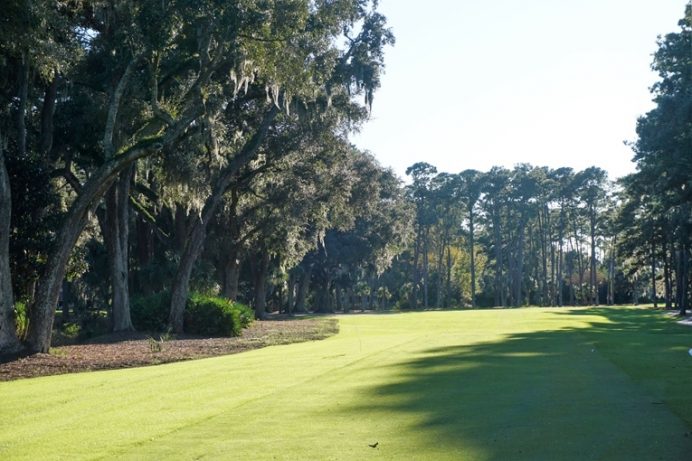
No surprise that as the 11th elbows left, the 12th goes right.

Today’s hole location is front center. A back left hole on this zig-zag green could be 15 yards left and 35 yards back, requiring perhaps three more clubs as well as carrying the front left bunker. For greens small in stature, it is amazing how the hole’s vary with each day’s hole location.
Thirteenth hole, 375/340 yards; Having Pat Ward-Thomas select this as his favorite thirteenth proved a sure-fire way to have greatness stamped upon it when The World Atlas of Golf was published in 1976. Even better, it is well nigh impossible to imagine that this hole has ever disappointed a single visitor, no matter how sky-high their expectations. Historically, the ninth and thirteenth represented an important turning point. Though Oakmont, Merion, and Pine Valley had long been the standard-bearers for the merit of short two shotters, architects had nudged away from them in the 1950s and 1960s. Harbour Town marked a welcome return to this genre of hole. Now, such holes are the present darlings in architecture and are considered a must in any modern design. The two at Harbour Town offer ‘fortress type’ defenses at the green, which have largely thwarted gains in technology. Good luck trying to strangle the desired birdie out of either! Certainly, the role and desirability of sub-360 yard holes was one of Nicklaus’s primary takeaways from the Harbour Town project and he delivered the goods when he built the fourteenth at Muirfield Village, the third at Cabo Del Sol and a host of other ones.
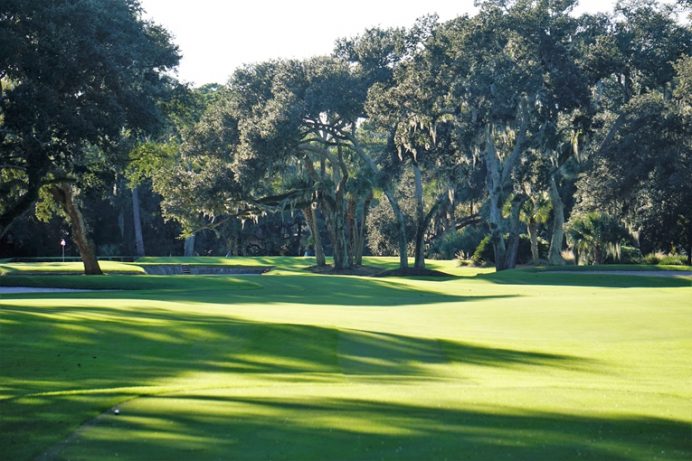
The 13th fairway offers more land movement in part because Dye needed more fill for the raised …
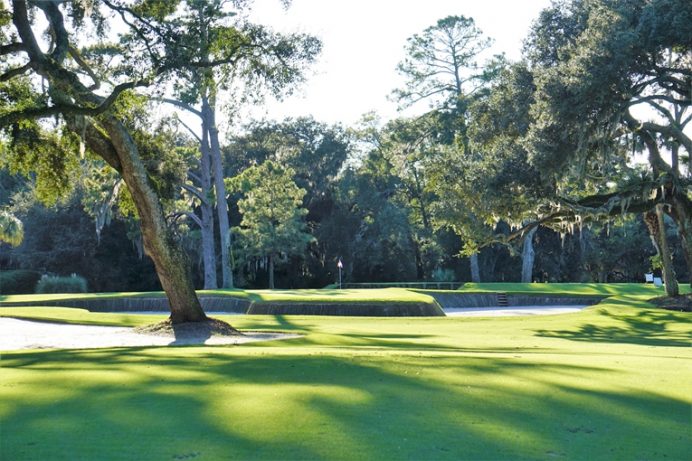
… 13th green pad.
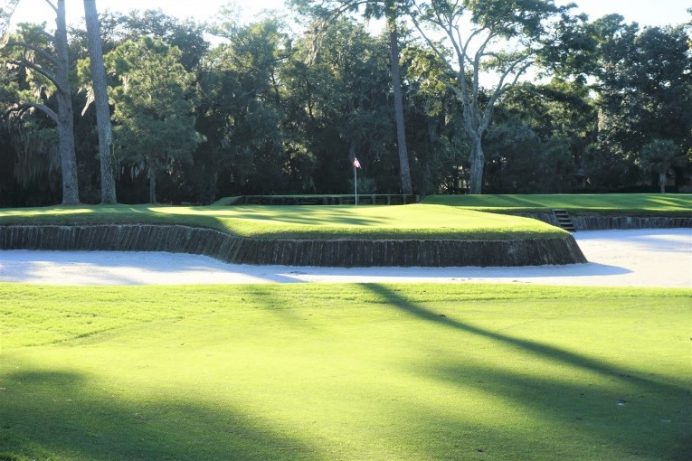
The 13th green putting surface protrudes into the bunker before flaring out to the left rear. Forward hole locations are particularly problematic.

As seen from the right, the bunker starts off less than three in depth at the front and rises to over five feet at the back.
Fourteenth hole, 190/145 yards; This one-shotter started life asking the professional to hit a ~7 iron to the green under calm conditions. It still does so today but 40 yards have been added to its original length of 150 yards. Imagine that – Needing to increase a hole’s length by over 25% just to have players have a similar club in! Such is how the game has changed, but that’s the beauty of Harbour Town’s design: with targets this challenging, little else has had to be done. Somewhat shockingly, during the 2015 RBC, it played as the toughest hole on the course, average .324 shots above par, making it the single hardest par three the professionals faced on tour all year. Yet, that isn’t a one-off event. According to Shot Link, in 2005, only the Road Hole played more over par than this one shotter. And again in 2016, this was the single toughest one shotter the professionals played all year. Yikes – what gives?! In addition to the extra yards, tree growth along the left for five decades has made this hole more mischievous with time because a simple bailout left is no longer readily afforded. Additionally, a hidden back pit famously awaits, very much crafted in the Scottish theme of not guaranteeing the player a perfect stance or easy swing at the ball. All told, the fourteenth punches above its weight and is the umpteenth example found already in the round that distance isn’t a prerequisite for challenge.
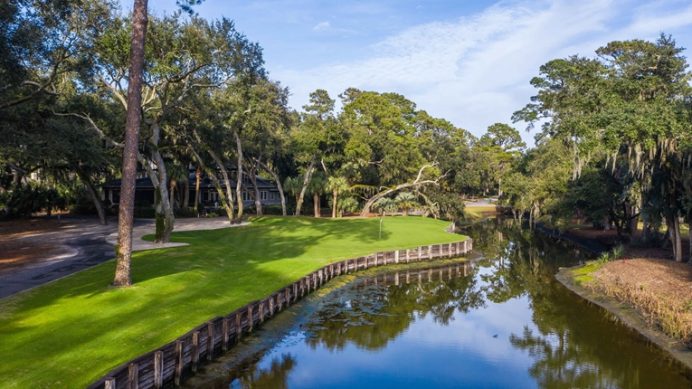
The 14th calls for exasperating accuracy (photo courtesy of PJ Koening Golf Photography).
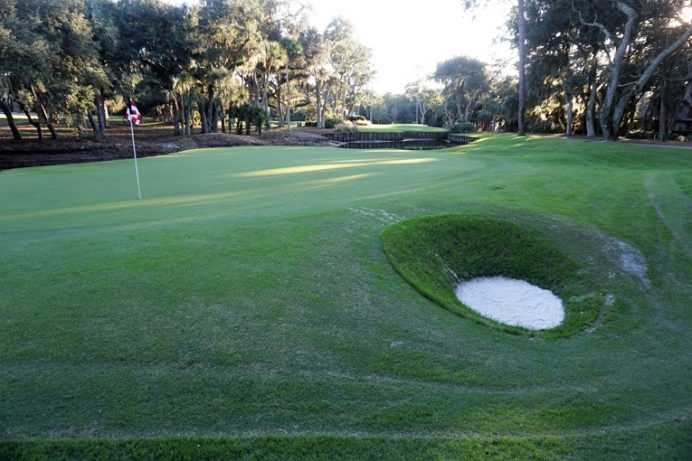
The saying about a bunker that is barely big enough for ‘an angry man and his ball’ originated in Scotland and applies at Harbour Town too.
Fifteenth hole, 590/540 yards; When this hole (the only par five on the back) was unveiled, it was instantly revered for being one of the true great three shotters built in the modern era. Five decades later and with technology on a tear, no par five is unreachable in two but the hole’s strategic merit has stood it in good stead. The need for an arrow straight drive can be off-putting but is step one toward success. For most resort guests, step two is to properly position your second shot to the right of a lagoon that emanates from near the green and extends back 100 yards. From there, the pitch might be the easiest of the three shots. Originally one of the smallest putting surfaces, the green was expanded in 1999 by Dye to spread out the foot traffic – and ball marks – at this very popular resort course. He did so by adding a bowl contour back left that actually makes a birdie a distinct possibility when the hole is there. That’s only though after two well played shots. Living near Pinehurst, what is remarkable to the author is the hole’s loose resemblance to the tenth hole at Pinehurst No. 2. As is well known, Dye was enlisted at Fort Bragg during the 1940s and frequently ventured to nearby Pinehurst where he struck up a friendship with Donald Ross. Both the tenth at Pinehurst and the fifteenth at Harbour Town are of similar length and bend left approximately 115 yards from their respective greens. Each is well guarded on the inside where the holes elbow and require thoughtful golf. To the author at least, the similarities are more than a coincidence and represent another way in how the Golden Age of architecture influenced the best architects post-World War II.
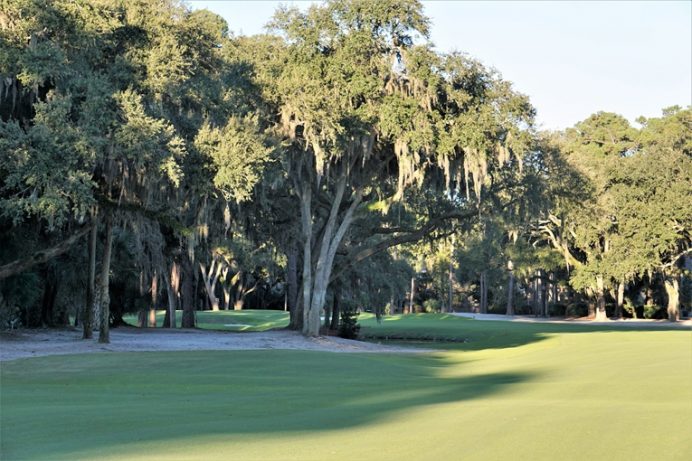
As seen from 200 yards from the green, the 15th fairway bends left around a lagoon and a copse of pines and oaks. Hard as it is to believe, today’s professionals have the ability to hoist a ball high enough to carry the trees and reach the green from 275 yards away.
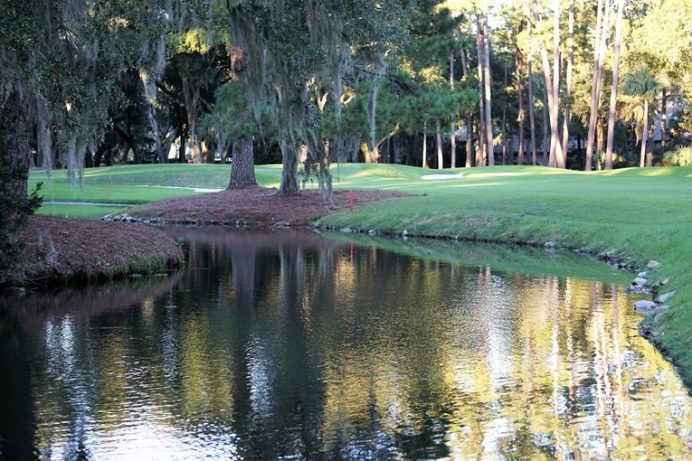
However, such tactics are not without risk. A poor second shot can bring a 6 or even 7 into the equation – and nothing is more infuriating to a strong player than that.
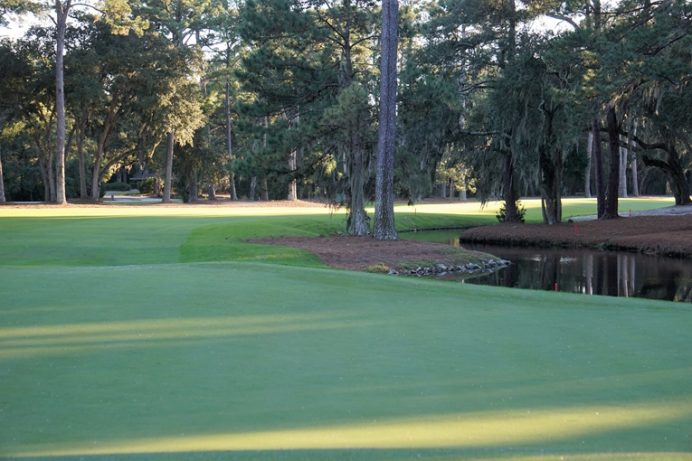
The view from behind the green. Is the golfer heading to the 16th tee with a skip in his step or fuming from making a mess of the hole?
Sixteenth hole, 435/360 yards; The golf has been a treelined affair to date and now begins the graceful transition to the Calibogue Sound. As far as the author is aware, this hole introduced the concept of a ‘waste bunker.’ With a floor made of Coquina Shell, the 135 yard long waste bunker dominates the inside of the dogleg left and is played as through the green, meaning the golfer is allowed to ground his club. Certainly a novel concept, this waste area serves as another example whereby something fresh and innovative enthused a playing vitality to an otherwise flat parcel of land. The author can’t help but think back to Pete and Alice Dye’s 1963 adventures in Scotland whereby they were exposed to things they had never seen before. Here at Harbour Town, they return the favor, showing that great architecture need not adhere to established guidelines. Just as their trip to Scotland opened their eyes, so has Harbour Town to a bunch of today’s architects. Also, as an example of how Harbour Town has evolved, this unique feature saw a change. Over time, the professionals became more adept at hitting off the hardpan and this waste area lost some of its teeth. Therefore, in 2014, Dye installed four island mounds within the waste area. The golfer is no longer guaranteed a level lie and an uncomplicated swing should his tee ball venture left. Its another design cue that Dye picked up in Scotland: hazards are hazardous and need to be avoided. With the integrity of the hazard restored, the golfer is no longer so cavalier off the tee and hole once again plays as Dye intended.

The course’s largest bunker is found on the inside of the dogleg left 16th. The tension created between it and two central pine trees in the fairway make the 16th the tactical challenge that it was always intended to be.
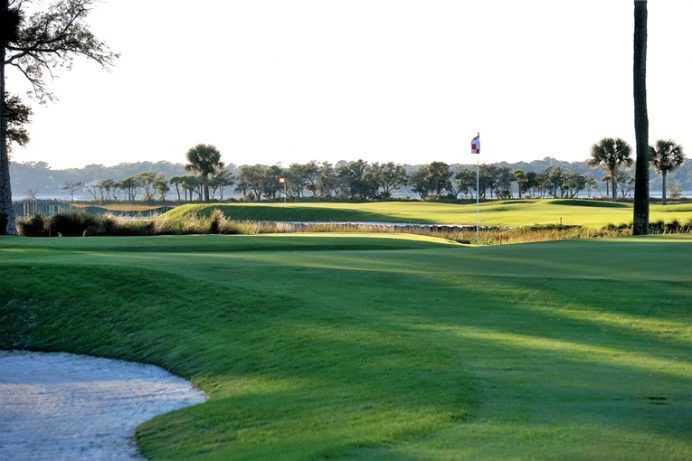
The trees have sheltered the golfer somewhat from the full effects of the coastal breezes to date. That changes with the approach to the 16th. Will the golfer correctly assess the wind’s full affect?
Seventeenth hole, 215/150 yards; Breathtaking, the penultimate hole transports the golfer to the edge of Calibogue Sound. Standing on the tee, nearby pines hinder a complete read on the brunt of the wind. Indeed, the good player readily mis-clubs here by 2 clubs more than any hole in world golf with which the author is familiar. The locals pay close attention to the water movement in front of the tee as well as the swaying grasses in the marsh for guidance; certainly the thickset Palmetto trees behind the green are a poor barometer of the wind’s strength. Apart from the wind, other attributes make depth perception elusive – and we have seen these factors throughout the round. First, there is the absence of framing; note the clean drop beyond the green in the first photograph below. The trees on the spit of land in the distance are actually 350 yards away. Second, another of Dye’s oddly configured bunkers helps obfuscate exactly where the flag is relative to the bunker, which is triple the length of the green and starts back left and finishes front right of the green by 50 yards. Third, the green itself is again much deeper than wide. At 35 yards deep, a back hole location can require three clubs more than a front one. Throw in the wind and it is the sort of crafty hole – within reach for all, yet elusive to hit in regulation – that defines the playing experience at Harbour Town.
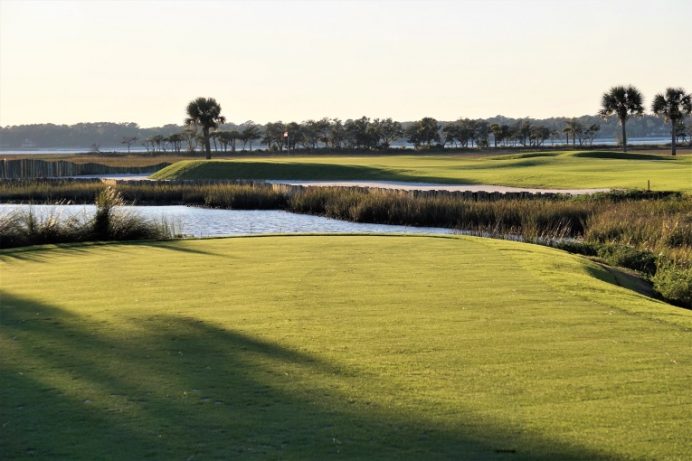
The stunning view from the 175 yard tee. On the day that this photograph was taken, John Farrell, Director of Golf, stated he would play a 220 yard shot to counteract the wind’s strength.
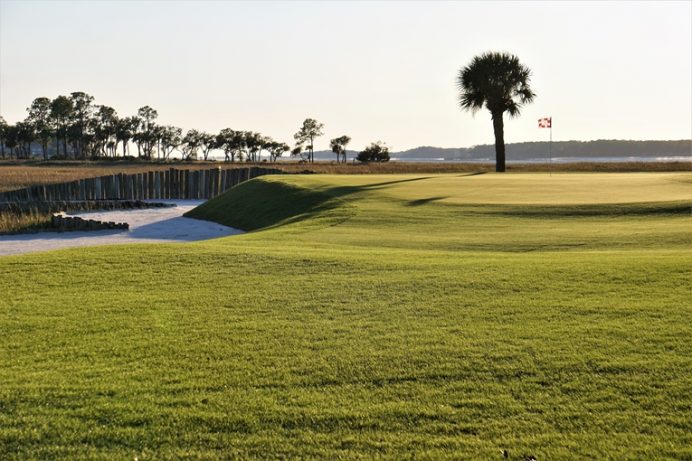
Expansive views unfold across the waterway to Daufuskie Island as one approaches the long green, which is narrow in front before widening toward the rear. The short grass prior to the putting surface is the golfer’s friend and is a fine place to miss, especially when the hole is forward.
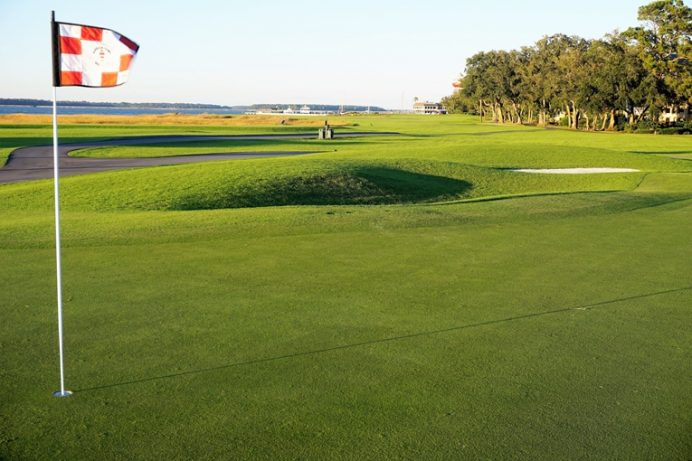
The famous candy cane colored lighthouse peeks out in the distance and makes its first appearance as one stands on the 17th green.

The depth of the left greenside bunker is evident in this view from back left. So too is the strength of the wind.
Eighteenth hole, 470/415 yards; How best for such a design to end? The golfer has just spent the past 3 1/2 hours tactical placing his ball in the fairway to best approach the small, angled greens. All of a sudden, the golf bursts out onto a huge, open stage and faces the widest fairway in South Carolina at 90 yards in width. It is an unexpected turn of events – and all the better for it. The tees, fairway and green are all at grade and the absence of any mounding helps lend the hole its timeless appeal. With the wind frequently off the left, how to hit the green, which is a mere 16 yards across and 27 yards deep? Does the player possess the courage to throw his approach left over the sound and let the wind bring it back onto the putting surface? It is a shot for the ages. When thinking about America’s Atlantic seaboard, few Home holes actually finish along it. Exceptions include Seminole, The Ocean Course at Kiawah Island, and Eastward Ho! but given its length of 2,000+ miles, the golfer readily hopes for more. Harbour Town delivers on those dreams and the rousing nature of both the tee ball and approach are due to the thumb of land that protrudes into Calibogue Sound. It was created from the material dredged from the construction of the harbor behind, which occurred simultaneously with that of the course. Such redistribution of land would not be allowed today, which is another way of saying, don’t hold your breath in hopes of ever seeing a better finishing hole on the Eastern Seaboard.
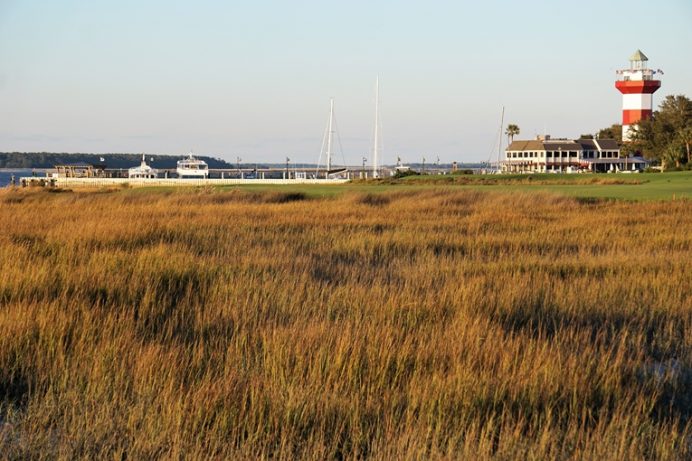
The unbridled joy of the Home hole at Harbour Town makes it Dye’s finest finishing hole out of the 100+ courses that he built.
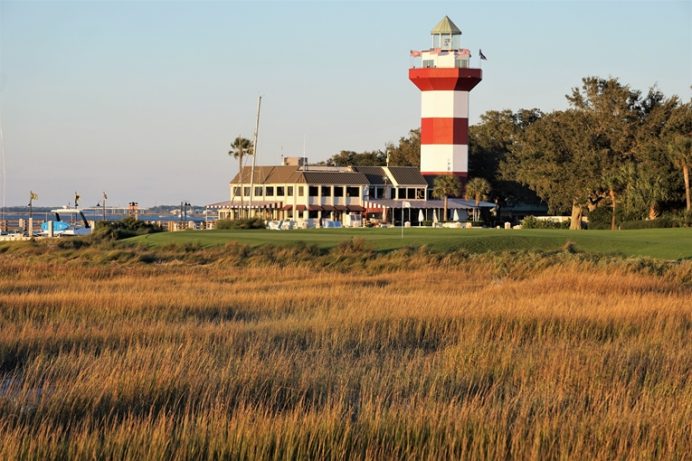
The approach to the Home green. Few holes in world golf hold the same appeal on both their drive and approach – but this is one of the them.
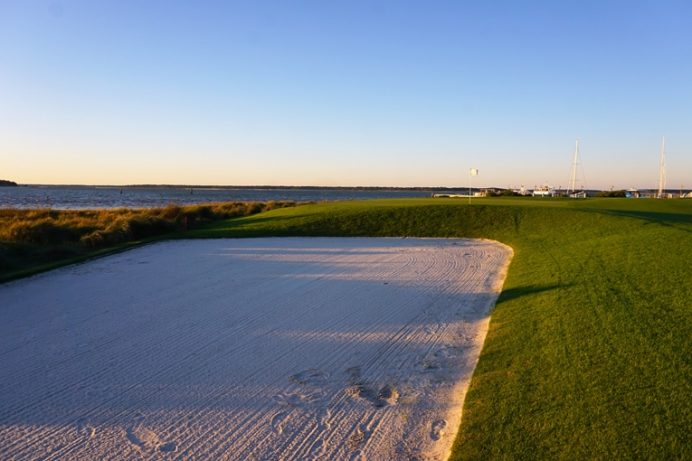
Holding true to the design tenet that a small green is a vexing target, the 18th green measures a mere XXXX square feet.
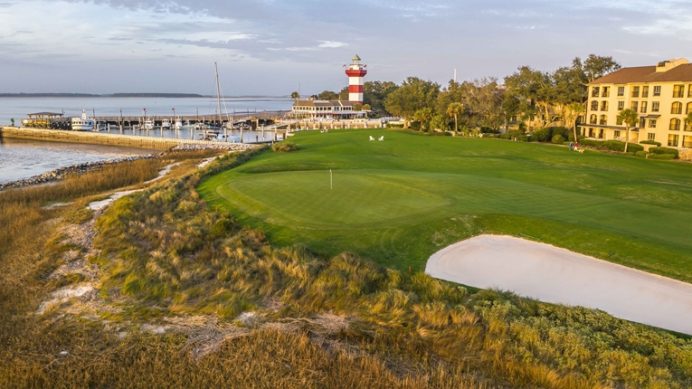
Similar to the 8th hole, the 50 yards of short grass right of the green make aiming at the green more difficult, not less.

This view back down the Home hole conveys its sweeping appeal, as well as its timeless man v. nature allure.
There you have it. Nicklaus himself sums up the course and today’s RBC Heritage well when he says, “It was a great project, attracted great golfers and still does today and I think that’s a testament to Pete and what Charles Fraser wanted to accomplish there and the quality and class of the tournament.”
Has Harbour Town stood the test of time? Certainly, the professionals have always loved it. In 2012, they voted it their second favorite course for architectural quality, behind Augusta National and ahead of Riviera in a poll conducted by Golf World. Here is what several have said since:
Luke Donald
“Modern architects should take a long look at Harbour Town and realize they don’t need to build long, hard courses to make them tough.”
Jason Day
“You can’t overpower this course. You have to position yourself off the tee to attack the flags, and your short game has to be sharp. It’s one of the few ‘old school’ courses we play throughout the year.”
David Lingmerth
“I enjoy these old-style golf courses like Harbour Town where you have to place your ball off the tee. You really have to play a strategic game here.”
Its list of winners over the past five decades is second to none, including Palmer, Johnny Miller, Irwin, Nicklaus, Watson, Faldo, Price, Norman, and Love with 5. In fact, in its first 20 PGA Tour events, only two winners didn’t also win a major. Impressive as the above comments are, what is really telling is the underlying wistfulness that make it clear how much the professionals embrace the opportunity to hit shots and be creative. Among Americans, nobody embraced the need to invent shots and get on with play better than Tom Watson. No surprise that Harbour Town resonates so much with him. He states, ‘Anyone who has an interest in golf course design or architecture must include a study of the Harbour Town Golf Links – I’ve felt this way since we first played there and feel the exact same way today’. When he says ‘today’, he said those words on December 16th, 2020. He went on to add, ‘Small greens that require talent like they have, we just don’t see enough of anymore. Maybe because I grew up with small greens in Kansas City, I just love the greens at Harbour Town, it’s too bad we’ve gotten away from this style.’
What Dye and Nicklaus created was a one-off the day it opened. It represented a marked departure from what the other lead architects of the day were doing – and it could have been a complete miss. There were no guarantees that a 6,600 yard course featuring railroad ties and tiny greens would be well received. Give Charles Fraser credit for letting the course unfold in the manner in which it did. Plenty of owners would have waffled, opting for something more mainstream. Yet, Dye’s recent trips to the United Kingdom had instilled in him an unshakeable confidence as to what constituted good golf. When you add in Nicklaus’s contributions and the hundreds of shots he hit during construction, the playing values of Harbour Town are second to none. Sure there have been tweaks over the years as enumerated in this profile but as far as the author is aware, Harbour Town adheres the closest to its original form of any Dye design.
Nicklaus’s words predicting great things for Dye proved prophetic. Anyone with the capability, let alone the vision, to build Harbour Town’s quartet of one shotters, its famed short par fours, and eighteenth hole was clearly a man destined to standout in his profession. And for the next fifty years (!), Dye did so. True, before Harbour Town, he had built of note Crooked Stick in Indiana and The Golf Club in Ohio, both of which also featured holes never quite seen before. The difference at Harbour Town was that the course gained instant notoriety via television as compared to the two discrete private clubs. The reach that television provided proved a pivotal moment for Dye and the ascent of his career. Over the next two decades, a host of future star architects including Bill Coore, Tom Doak, Tim Liddy, Rod Whitman, Brian Curley, and Bobby Weed would work for Dye. Nicklaus himself would go on to design Muirfield Village several years later and start a design empire. Suffice to say, the Dye design tree is immense and is as responsible for the face of modern architecture as any single entity. To learn more, be sure to set aside a good half-hour to tour the Pete Dye Room just inside the Harbour Town clubhouse.
Without doubt, Fraser’s dream has been fully realized. When Arnold Palmer emerged victor at the inaugural PGA Tour event, all the accompanying praise from the professionals and the media saw Harbour Town’s star ascend. Nothing has changed since. Through the lens of time, history now shows that the event amounted to Pete Dye’s coming-out party. Modern architecture received a much needed boost and a change of direction. Golf design was never the same thereafter in North America.
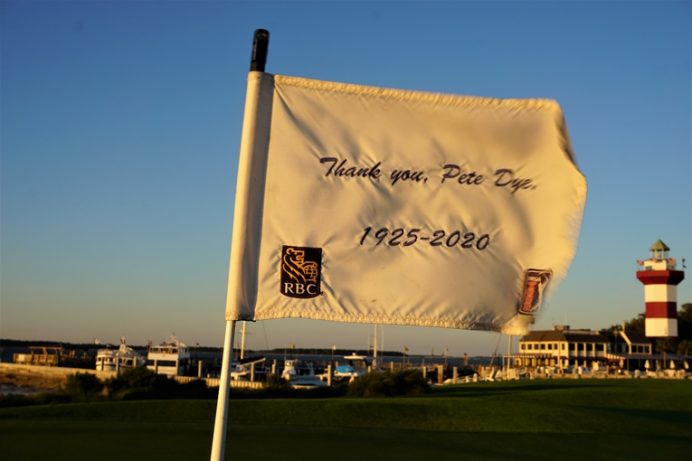
The Home flag says it all.

